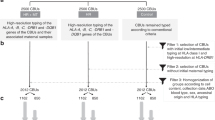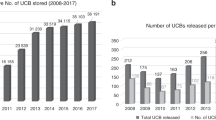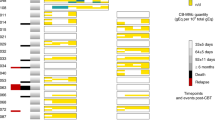Abstract
Several Cord Blood (CB) Bank studies suggested that ethnicity impaired CB unit (CBU) qualification. The Bone Marrow Donors Worldwide registries present an over-representation of unrelated donors (UD) from Northwestern European descent. This raises the question of equality of access to hematopoietic stem cells transplant, especially in the Mediterranean zone, which has taken in many waves of immigration. The aim of our study is to address whether, in the Marseille CB Bank, CBU qualification rate is impaired by geographic origin. The study compared biological characteristics of 106 CBU disqualified for total nucleated cell (TNC) count (dCBU) and 136 qualified CBU in relation to registry enrichment and haplotype origin. A high proportion (>80%) of both dCBU and CBU had at least one non-European haplotype and enrich CB and UD registries to a higher extent than those with two European haplotypes (P<0.001). No difference was observed between TNC count and volume according to geographic origin. Our study shows that diverse Mediterranean origins do not have an impact on the CBU qualification rate. Partnership with Mediterranean birth clinics with highly trained staff is a reasonable option to increase the HLA diversity of CB Bank inventories and to improve the representation of minorities.
This is a preview of subscription content, access via your institution
Access options
Subscribe to this journal
Receive 12 print issues and online access
$259.00 per year
only $21.58 per issue
Buy this article
- Purchase on Springer Link
- Instant access to full article PDF
Prices may be subject to local taxes which are calculated during checkout

Similar content being viewed by others
References
Cheuk DK . Optimal stem cell source for allogeneic stem cell transplantation for hematological malignancies. World J Transplant 2013; 3: 99–112.
Danby R, Rocha V . Improving engraftment and immune reconstitution in umbilical cord blood transplantation. Front Immunol 2014; 5: 68.
Kurtzberg J, Cairo MS, Fraser JK, Baxter-Lowe L, Cohen G, Carter SL et al. Results of the cord blood transplantation (COBLT) study unrelated donor banking program. Transfusion 2005; 45: 842–855.
Page KM, Mendizabal A, Betz-Stablein B, Wease S, Shoulars K, Gentry T et al. Optimizing donor selection for public cord blood banking: influence of maternal, infant, and collection characteristics on cord blood unit quality. Transfusion 2014; 54: 340–352.
Zarrabi M, Mousavi SH, Abroun S, Sadeghi B . Potential uses for cord blood mesenchymal stem cells. Cell J 2014; 15: 274–281.
Shlebak AA, Roberts IA, Stevens TA, Syzdlo RM, Goldman JM, Gordon MY . The impact of antenatal and perinatal variables on cord blood haemopoietic stem/progenitor cell yield available for transplantation. Brit J Haematol 1998; 103: 1167–1171.
George TJ, Sugrue MW, George SN, Wingard JR . Factors associated with parameters of engraftment potential of umbilical cord blood. Transfusion 2006; 46: 1803–1812.
Cobellis L, Castaldi MA, Trabucco E, Imparato G, Perricone F, Frega V et al. Cord blood unit bankability can be predicted by prenatal sonographic parameters. Eur J Obstet Gynecol Reprod Biol 2013; 170: 391–395.
Jamali M, Atarodi K, Nakhlestani M, Abolghasemi H, Sadegh H, Faranoosh M et al. Cord blood banking activity in Iran National Cord Blood Bank: a two years experience. Transfus Apher Sci 2014; 50: 129–135.
Keersmaekers CL, Mason BA, Keersmaekers J, Ponzini M, Mlynarek RA . Factors affecting umbilical cord blood stem cell suitability for transplantation in an in utero collection program. Transfusion 2014; 54: 545–549.
Ballen KK, Kurtzberg J, Lane TA, Lindgren BR, Miller JP, Nagan D et al. Racial diversity with high nucleated cell counts and CD34 counts achieved in a national network of cord blood banks. Biol Blood Marrow Transplant 2004; 10: 269–275.
Barker JN, Scaradavou A, Stevens CE . Combined effect of total nucleated cell dose and HLA match on transplantation outcome in 1061 cord blood recipients with hematologic malignancies. Blood 2010; 115: 1843–1849.
Gragert L, Eapen M, Williams E, Freeman J, Spellman S, Baitty R et al. HLA match likelihoods for hematopoietic stem-cell grafts in the U.S. registry. N Eng J Med 2014; 371: 339–348.
Ustun C, Bachanova V, Shanley R, MacMillan ML, Majhail NS, Arora M et al. Importance of donor ethnicity/race matching in unrelated adult and cord blood allogeneic hematopoietic cell transplant. Leuk Lymphoma 2014; 55: 358–364.
Barker JN, Byam CE, Kernan NA, Lee SS, Hawke RM, Doshi KA et al. Availability of cord blood extends allogeneic hematopoietic stem cell transplant access to racial and ethnic minorities. Biol Blood Marrow Transplant 2010; 16: 1541–1548.
Ballen KK, Klein JP, Pedersen TL, Bhatla D, Duerst R, Kurtzberg J et al. Relationship of race/ethnicity and survival after single umbilical cord blood transplantation for adults and children with leukemia and myelodysplastic syndromes. Biol Blood And Marrow Transplant 2012; 18: 903–912.
Askari S, Miller J, Chrysler G, McCullough J . Impact of donor- and collection-related variables on product quality in ex utero cord blood banking. Transfusion 2005; 45: 189–194.
Cairo MS, Wagner EL, Fraser J, Cohen G, van de Ven C, Carter SL et al. Characterization of banked umbilical cord blood hematopoietic progenitor cells and lymphocyte subsets and correlation with ethnicity, birth weight, sex, and type of delivery: a Cord Blood Transplantation (COBLT) Study report. Transfusion 2005; 45: 856–866.
Akyurekli C, Chan JY, Elmoazzen H, Tay J, Allan DS . Impact of ethnicity on human umbilical cord blood banking: a systematic review. Transfusion 2014; 54: 2122–2127.
King RJ, Di Cristofaro J, Kouvatsi A, Triantaphyllidis C, Scheidel W, Myres NM et al. The coming of the Greeks to Provence and Corsica: Y-chromosome models of archaic Greek colonization of the western Mediterranean. BMC Evol Biol 2011; 11: 69.
Institut National de la Statistique et des Etudes Economiques Population selon nationalité au 1er janvier 2011. http://www.insee.fr/fr/themes/tableau.asp?reg_id=5&ref_id=poptc02501 2011.
Magalon J, Billard-Daufresne LM, Gilbertas C, Hermanche E, Simon S, Lemarie C et al. Assessing the HLA diversity of cord blood units collected from a birth clinic caring for pregnant women in an ethnically diverse metropolitan area. Transfusion 2014; 54: 1046–1054.
Gascard C, Boulanger F, Lambiliotte A, Depret S, Nelken B, Royez-Brovelli M et al. [Cord blood collection for potential stem cell transplantation to a family member: the long-term experience of a level-III maternity unit]. Presse medicale 2008; 37: 1731–1738.
Solves P, Perales A, Mirabet V, Blasco I, Blanquer A, Planelles D et al. Optimizing donor selection in a cord blood bank. Eur J Haematol 2004; 72: 107–112.
Wang TF, Wen SH, Yang KL, Yang SH, Yang YF, Chang CY et al. Reasons for exclusion of 6820 umbilical cord blood donations in a public cord blood bank. Transfusion 2014; 54: 231–237.
Ray JG, Sgro M, Mamdani MM, Glazier RH, Bocking A, Hilliard R et al. Birth weight curves tailored to maternal world region. J Obstet Gynaecol Can 2012; 34: 159–171.
Hequet O . [The methods used to collect hematopoietic stem cells]. Transfus Clin Biol 2011; 18: 230–234.
Acknowledgements
This work was supported in part by Agence de la Biomédecine through funding ‘Research and Graft – 2013’ ADB/EBe-DLE. We thank the generous donors and their families for donating their cord blood for public use. The authors acknowledge all the personnel at the Hôpital de la conception birth clinic, at the Institut Paoli-Calmettes cell therapy facility and at the Etablissement Français du Sang Alpes Méditerranée department of Histocompatibility and Immuno-genetics for their contribution to the daily routine of the Marseille CBB. We also thank P.A. Gouraud for his advice on statistical analyses.
Author information
Authors and Affiliations
Corresponding author
Ethics declarations
Competing interests
The authors declare no conflict of interest.
Rights and permissions
About this article
Cite this article
Bordoni, C., Magalon, J., Gilbertas, C. et al. Cord blood collection and banking from a population with highly diverse geographic origins increase HLA diversity in the registry and do not lower the proportion of validated cord blood units: experience of the Marseille cord blood bank. Bone Marrow Transplant 50, 531–535 (2015). https://doi.org/10.1038/bmt.2014.314
Received:
Revised:
Accepted:
Published:
Issue Date:
DOI: https://doi.org/10.1038/bmt.2014.314



